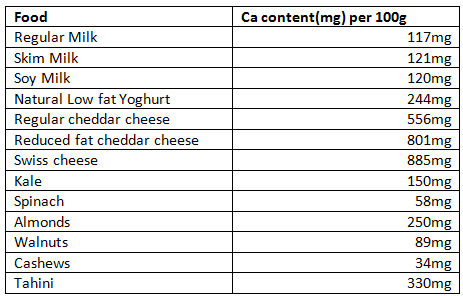
Calcium is a nutrient often associated with dairy however there are many other sources in the diet to obtain this important mineral. Calcium is the most abundant mineral in the body and it’s stored in our teeth and bones. The role calcium plays in maintaining the strength and structure of bones is well known however calcium also plays key roles in many other functions, such as muscle contractions, enzyme function and even in heart beat regulation so it is vital we get adequate intake through our diet. Sources of calcium are often only associated with milk, yoghurt and cheese however there are several other sources that assist us in obtaining this important mineral. Let’s take a look at how dairy and non dairy sources of calcium compare.

It is important to note that serving sizes of each food do vary. For example a serve of milk is 200ml, whereas a serve of nuts is only 30g. Cheese yields the most calcium per 100g out of the foods listed. The second richest source comes from Tahini, a sesame seed spread. Yogurt and Almonds sit evenly with around 250mg of calcium per 100g. Interesting, other nuts such as cashews and walnuts contain much less calcium than almonds. Dairy and soy milk varieties remain relatively even (approximately 120mg Calcium). Soy milk must be fortified with calcium in Australia and therefore the calcium content can depend on the brand. Kale contains 150mg of calcium per 100g which is a significant amount for a vegetable, especially when compared to spinach which contains only 58mg, however, you may find it hard to eat 100g of kale daily, so try to obtain calcium through a varied and balanced diet.
